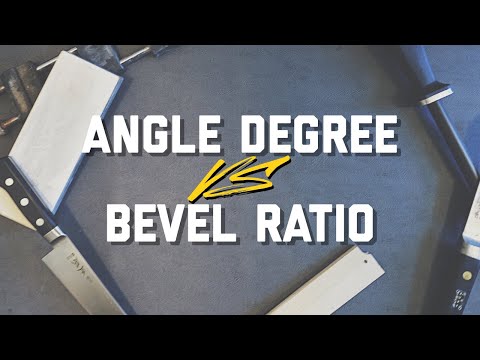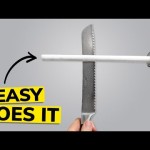
ecea25e52206c27699f310b783549947
Sharpening a knife is an essential skill for any chef or home cook. It is important to understand the basics of knife sharpening, including the different types of knife bevels. In this article, we will discuss the basics of knife bevels and how they affect the sharpness of a knife. We will also provide tips on how to sharpen a knife and maintain its sharpness. Finally, we will discuss the different types of knife sharpeners available and how to choose the right one for your needs.
What bevel setting for knife sharpening
Sharpening a knife is an important part of kitchen maintenance. It is important to use the correct bevel setting when sharpening a knife to ensure that it is sharpened correctly and safely. The bevel setting is the angle at which the blade is sharpened.
The most common bevel setting for knife sharpening is 20 degrees. This is the angle that most kitchen knives are sharpened at. It is a good angle for most kitchen knives as it provides a good balance between sharpness and durability.
For knives that are used for more delicate tasks, such as filleting fish or slicing vegetables, a lower bevel setting of 15 degrees may be more suitable. This will provide a sharper edge but will not be as durable as a 20 degree bevel setting.
For knives that are used for more heavy-duty tasks, such as chopping wood or splitting logs, a higher bevel setting of 25 degrees may be more suitable. This will provide a more durable edge but will not be as sharp as a 20 degree bevel setting.
It is important to remember that the bevel setting is only one part of knife sharpening. It is also important to use the correct sharpening stone and to use the correct technique when sharpening a knife.
In conclusion, the most common bevel setting for knife sharpening is 20 degrees. For more delicate tasks, a lower bevel setting of 15 degrees may be more suitable, and for more heavy-duty tasks, a higher bevel setting of 25 degrees may be more suitable. It is important to remember that the bevel setting is only one part of knife sharpening and that the correct sharpening stone and technique should also be used.
What are the basics of sharpening knives
Sharpening knives is an important skill to have in the kitchen. It is essential for keeping your knives in good condition and ensuring that they are safe to use. Knowing the basics of sharpening knives can help you keep your knives in top shape and make them last longer.
Types of Sharpeners
There are several types of sharpeners available, including electric sharpeners, manual sharpeners, and sharpening stones. Electric sharpeners are the easiest to use, but they can be expensive. Manual sharpeners are more affordable and require more skill to use. Sharpening stones are the most traditional way to sharpen knives and require the most skill, but they can also produce the sharpest edges.
Sharpening Technique
When sharpening a knife, it is important to use the correct technique. Start by holding the knife at a 20-degree angle to the sharpening stone. Then, use a back-and-forth motion to sharpen the blade. Make sure to keep the angle consistent throughout the sharpening process. After a few strokes, check the blade to make sure it is sharp. If not, repeat the process until the blade is sharp.
Maintenance
Sharpening knives is only part of the process of keeping them in good condition. It is also important to maintain them properly. After sharpening, make sure to clean the blade with a damp cloth.
This will remove any metal shavings that may have been created during the sharpening process. Additionally, it is important to store knives in a safe place, such as a knife block or a drawer, to prevent them from becoming dull or damaged.
Conclusion
Sharpening knives is an important skill to have in the kitchen. Knowing the basics of sharpening knives, such as the types of sharpeners available and the correct sharpening technique, can help you keep your knives in top shape and make them last longer. Additionally, it is important to maintain knives properly after sharpening and store them in a safe place.
What are the 3 methods of sharpening knives
Knives are essential tools in the kitchen, and keeping them sharp is important for safety and efficiency. There are three main methods of sharpening knives: honing, sharpening, and stropping.
Honing
Honing is the process of realigning the microscopic teeth of the blade. This is done with a honing steel, which is a rod made of steel or ceramic. The honing steel should be held at a 20-degree angle to the blade and drawn along the length of the blade in a sweeping motion. This should be done on both sides of the blade.
Sharpening
Sharpening is the process of removing metal from the blade to create a new edge. This is done with a sharpening stone, which is a flat stone made of diamond, ceramic, or water. The stone should be held at a 20-degree angle to the blade and drawn along the length of the blade in a sweeping motion. This should be done on both sides of the blade.
Stropping
Stropping is the process of polishing the blade to a razor-sharp edge. This is done with a leather strop, which is a strip of leather with a compound on one side. The strop should be held at a 20-degree angle to the blade and drawn along the length of the blade in a sweeping motion. This should be done on both sides of the blade.
By honing, sharpening, and stropping your knives regularly, you can keep them in top condition and ensure that they are safe and efficient to use.
What is the best bevel angle for a knife
Knives are essential tools in the kitchen, and the bevel angle of the blade is an important factor in determining the knife’s performance. The bevel angle is the angle between the blade’s edge and the flat side of the blade. A knife’s bevel angle affects its sharpness, durability, and ease of sharpening.
The most common bevel angle for kitchen knives is between 15 and 20 degrees. This angle is sharp enough to cut through most foods, but not so sharp that it is difficult to sharpen. A 15-degree angle is considered the best for most kitchen knives, as it provides a good balance between sharpness and durability.
For knives that are used for more delicate tasks, such as filleting fish or slicing vegetables, a lower bevel angle of 10 to 12 degrees is recommended. This angle is sharper than the 15-degree angle, but it is also more fragile and prone to chipping.
For knives that are used for tougher tasks, such as chopping wood or cutting through bone, a higher bevel angle of 20 to 25 degrees is recommended. This angle is more durable and can withstand more abuse, but it is also less sharp than the lower angles.
The best bevel angle for a knife depends on its intended use. For most kitchen knives, a 15-degree angle is recommended. For more delicate tasks, a lower angle of 10 to 12 degrees is recommended. For tougher tasks, a higher angle of 20 to 25 degrees is recommended.
We hope this article has helped you understand the basics of knife sharpening and the different types of knife bevels. We wish you the best of luck in your sharpening endeavors! Goodbye and take care!














